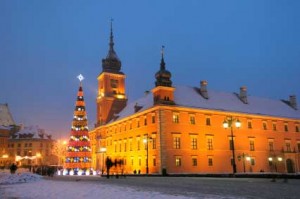Christmas in Poland: History, Family, Food and Generosity
Posted December 13, 2013 in Christmas Around the World by Dianne Weller

Give the French credit for bringing the word “gourmet” into the mainstream. And never forget that the Italians have made pasta and marinara sauce as common on American menus as Mexicans have made tacos and burritos.
But don’t let the people in these countries lull you into thinking that they—and they alone—corner the market on celebrating the communal value of food, especially during Christmas.
Poles deserve a seat at the table, too, because during Christmas in Poland, food plays a central role in the festivities, as the global tour of Christmas traditions at Ornamentshop.com clearly shows.
This is not to say that Poles have a single-minded purpose focused on their stomachs; far from it. About 90 percent of the country’s 38 million residents are Roman Catholic, so they celebrate St. Nicholas Day on December 6 and make a pilgrimage to Krakow on the first Thursday in December to see colorful Nativity scenes produced by artisans and novices alike.
Since 1937, the Krakow Market Square has consistently teemed with people who come to admire dozens of “Christmas cribs” and szopkas, or stables that are made to look like churches.
Christmas in Poland: A Celebration of Ethnic Food
But then look out for Christmas Eve, which is known wigilia. This lavish feast begins as soon as the first star is spotted in the night sky, just as the three wise men were guided by a glittering light in the night.
Wigilia begins with a custom that is similar to the religious practice of Communion: family members share oplateks, or wafers, toast each other with wishes of love, peace, happiness, prosperity and good health.
Then, a 12-course meal—representing Jesus’ 12 apostles—often begins with mushroom soup or barszcz beetroot soup with mushrooms. With the distinct smell of their beloved cabbage in the air, Poles then prepare for a plain cabbage dish with mushrooms or pierogis stuffed with cabbage. Either way, cabbage is almost always on the table during Christmas in Poland. The main and usually meatless course of wigilia is fish. It could be baked, fried or boiled fish; or it could be carp or pike set atop a rich sauce with steaming vegetables.
All of this is a precursor to dessert, which often includes Polish favorites such as poppy seed twists, honey gingerbread, crisp tarts known as łamańce or kruchalce and kutia,which is made of poppy seeds and boiled wheat with honey.
On Christmas Day, many towns in Poland mimic a grand event in Warsaw by staging their own three wise men parade, a custom that often ends with a prayer to the baby Jesus in a small stable.
Call it Christmas or Boze Narodzenie, as the Poles do. Share with your Polish and non-Polish friends alike on Facebook and Twitter. Christmas in Poland: A History, Family, Food and Generosity



